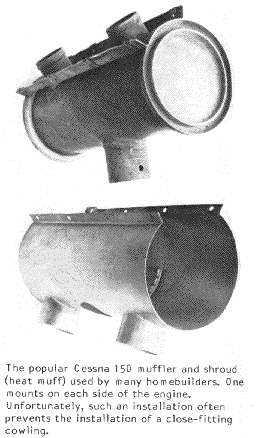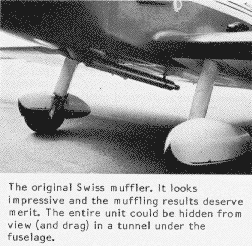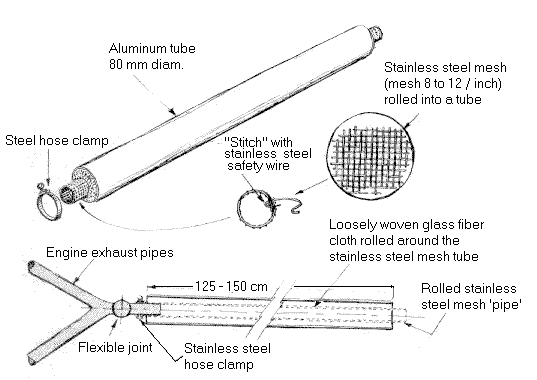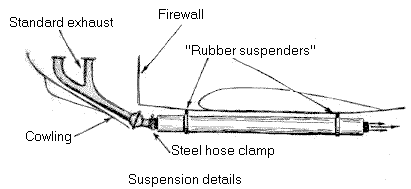Swiss style muffler
Excerpt from "Firewall Forward" by Tony Bingelis
(recommended)
The noise you associate with exhaust is due to the rapid expansion of air during combustion and to the turbulence of its high speed exit from the engine. Smooth out the combustion pulsations, reduce the turbulence of the exiting gases, and you will have succeeded in quieting the exhaust noises. The commonly accepted means for reducing the noise of engine exhaust is through the installation of one or more mufflers.
A muffler works by providing a large chamber in which the sound of combustion and turbulence are reduced. The quality of the muffling, therefore, depends on the volume of this chamber and on the downstream resistance the gasses encounter.
Unfortunately, the muffler chamber increases the downstream resistance, resulting in an undesirable increase in combustion chamber back-pressure and a reduction in power availability.
The addition of a muffling system on your aircraft, therefore, is likely to result in a loss of performance and an increase in cost, weight and maintenance. Unfortunately, while is often a negligible factor in larger, more powerful homebuilts, it has been an unacceptable burden for low or underpowered aircraft. It is unfortunate, but true, that any significant loss of available power in lightweight aircraft powered by a small engine is considered as unacceptable. For this reason, you will only rarely find a muffler installation in a homebuilt powered by an engine of less than 65 HP. Mufflers are particularly rare in VW engine installations.
This situation is changing, however. Ultralight aircraft are appearing with a variety of clever lightweight muffling devices for their angry, hornet-like, high reving engines. Much to their credit, ultralight aircraft builders are trying hard to muffle the shrill while of their low-powered engines.
As mentioned, in order to muffle engine noise, you must somehow smooth out the flow of the turbulent gases, or at least, modify the ordinary exhaust pulsations. Longer pipes do, of course, help a bit. So do some of the modifications of the tail pipe. Some builders add unusual treatments to the end of the tail pipes in order to effect some alteration in the exhaust pulsations.
One such variation, is to flatten the last six to eight inches of the tail pipe and then drill random holes in it. The effect of the flattened pipe, is to help accelerate the flow of exhaust gases. This type of tail pipe modification is standard on the VW-powered Fournier (a French-built motor sailplane). Furthermore, with the pipes pointed straight back, a little bit of jet assist is also realized.
Although these tail pipe designs do help to alter the noise patterns, they are not true mufflers that significantly suppress or reduce engine combustion noises. It is interesting to note that the tail pipe modification is most effective when both pipes exit at the same point and are as close together as possible.
How are they put together ?
The standard muffler consists of a tube of some specific length an diameter. It is usually a rather large stainless steel tube and may or may not have built-in internal baffles. The practice has long been to construct aircraft mufflers with baffles and with the inlet and outlet tubes staggered. In some mufflers, the exhaust gases are forced to change direction drastically in their pell-mell trip to the free atmosphere.
To construct your own muffler with similar baffles built-in, is a chore of questionable value, unless you have some relentless urge to experiment and to induce forced labor. The practical thing to do, would be to omit the baffles completely, as they usually are the first area of failure in the exhaust system. Burned, disintegrated or collapsed baffles in standard category aircraft often obstruct the flow of exhaust gases and have been known to cause serious loss of power or engine failure.
 Mufflers are most effective when they are located as close to the exhaust outlet of the cylinder as it is practical to place them. The Cessna 150 provides an example where this concept is effectively practiced. Its individual mufflers are hung on each side of the engine on short exhaust risers. In some Piper models, too, the cross-over system mufflers, are integrated as far upstream as possible.
Mufflers are most effective when they are located as close to the exhaust outlet of the cylinder as it is practical to place them. The Cessna 150 provides an example where this concept is effectively practiced. Its individual mufflers are hung on each side of the engine on short exhaust risers. In some Piper models, too, the cross-over system mufflers, are integrated as far upstream as possible.
As for the muffler size, the Cessna muffler is about 10 cm by 25 cm. (It looks bigger with the shroud around it.) These are really the minimum size for the muffling job at hand. Actually, a muffler measuring 15 cm by 25 cm, would be much more effective. With due regard for the extra weight and lack of space under the cowling, your own muffler(s) should be as large as possible - something on the order of at least 4.4 liters, if at all possible.
Forget about internal baffles, as their usefulness is questionable when everything is to be considered. Instead make the diameter as large as you can manage. A good length of tail pipe downstream from the muffler, will increase its effectiveness noticeable and will assist in smoothing out the pulsations of the exhaust gases.
The expense of good aircraft mufflers tends to keep them off most homebuilts. However, any builder can incorporate a standard aircraft muffler into his exhaust system with very little difficulty.
Ultralight builders are developing a variety of muffler-like tail pipes. These are proving quite effective and perhaps more homebuilders will find them suitable installations for conventional aircraft. One thing that most homebuilders will not do, is to stick the tail pipes straight up like a farm tractor even if that does direct the exhaust noise away from the populance below. It may be all right for an ultra-slow, ultralight, but a bit out of character for the racy little homebuilts.
Building your own
I think you must be aware, that attempting to build your own open chamber muffler would be more difficult than fabricating the basic exhaust pipe portion of the system. Most of us simply would not undertake the construction of a muffler system for that very reason. The FAA, in its Inspection Aids, has regularly reported frequent incidents arising from failures occurring in and around mufflers - especially at the point where the tail pipe attaches to them. Thus, the construction of a hand-made muffler, would have to be of high quality in order to be free of such difficulties.
The Swiss muffler

As you may know, Sweden and Switzerland were among the first two countries in the world to impose strict - nay, drastic - limitations against all noise pollution. Switzerland not only set low levels, they have enforced them since January, 1974. As a result of this action, a number of light aircraft, including some type-certified models, were grounded, (I repeat, GROUNDED!) until their owners did something about noise! Oh, the officials weren't prejudiced about aircraft, because the action affected motor bikes and trucks as well.
Needless to say, the homebuilders were motivated and quickly came up with an unusual muffler which seems to have become the standard Swiss homebuilt muffler.

Essentially, it consists of a length of stainless steel mesh rolled into a turbular shape. The inside diameter of the tube must be large enough to slip over the outside diameter of the engine's exhaust pipe. The length of the hand-made stainless "mesh" tube varies in length with the builder and, perhaps, the engine used. It seems, however, that most of them are about 120 to 150 cm in length. That's right, 1.2 to 1.5 meters long! This is for 65 to 85 HP aircraft, like most of the European two-seaters, the Jodels, Emeraudes, Mincabs, etc.
Next, loosely woven cloth, or what we call roving, is rolled around the stainless steel mesh tube and its diameter is built up until it becomes a tight push-fit into a seamless, 80 mm diameter aluminum tube. (This would be approximately 3 1/8 inches in diameter, if you don't have a metric scale). Do not use fiberglass mat, as it will probably shred away and be reduced to dust by vibration after very limited use. The aluminum tube is readily available in Europe, as this sort of tube just happens to be the standard vertical rainwater downspout found on houses. It is about 0.5 mm thick and can be obtained from building supply stores in europe. Any similar light-wall, large-diameter tube could be used. In the U.S. about the only source for such a large diameter aluminum, would be companies producing telescopes and telescope kits.
The whole assembly is then slung underneath the fuselage and clamped onto the single exhaust outlet with a steel clamp. The muffler is supported in at least two places along its length with steel clamps and rubber suspenders of a sort.

Way out, you say ? You may think this is ungainly, heavy and draggry, but perhaps we should focus on the results, which are outstanding. You no longer hear the exhaust, but - just the prop and the slipstream. It is reported that flying takes on a new dimension and taxiing on crowded ramps becomes a dangerous adventure, unless you have a wing walker to 'shoo' people away.
This muffler is certainly inexpensive and easy to manufacture and to maintain. Although its useful life as yet is unknown, inspection and replacement, even if a bit more frequent than for standard aircraft stainless steel mufflers, would certainly be no deterrent to its acceptance. This muffler system should not generate any power-robbing back pressure. It can be added to any existing design, although the aesthetic qualities might be subject to a few quaint remarks. Owners of replica warbirds could make theirs larger in diameter and pass them off as bombs or torpedoes. Most important, however, these mufflers do the job simply and permit the Swiss builders to continue flying in the face of restrictive governmental limitations.
On further reflection, there is no reason why the muffler could not be concealed in a sort of built-in trough underneath the fuselage - at least it's an idea worth trying.

The typical exhaust system is rather easy to construct and install if you do not have to install mufflers and heat muffs. A system complete with a muffler and heat exchangers will be a bit more difficult to design and to construct properly. It may even be more troublesome to maintain, but the results are worth it - a quiet airplane.
--oOo--
If you have any comments, please contact  ping@piteraq.dk
ping@piteraq.dk
 Updated 02-07-30 at 20:22
Updated 02-07-30 at 20:22
 Mufflers are most effective when they are located as close to the exhaust outlet of the cylinder as it is practical to place them. The Cessna 150 provides an example where this concept is effectively practiced. Its individual mufflers are hung on each side of the engine on short exhaust risers. In some Piper models, too, the cross-over system mufflers, are integrated as far upstream as possible.
Mufflers are most effective when they are located as close to the exhaust outlet of the cylinder as it is practical to place them. The Cessna 150 provides an example where this concept is effectively practiced. Its individual mufflers are hung on each side of the engine on short exhaust risers. In some Piper models, too, the cross-over system mufflers, are integrated as far upstream as possible.


